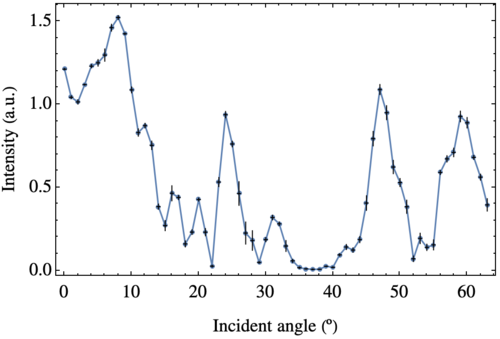Difference between revisions of "Bragg diffraction"
From Camilo's web

m (→Useful links) |
|||
| Line 32: | Line 32: | ||
== Useful links == | == Useful links == | ||
* The manual to set up the experiment is [http://camilopez.org/wiki/Media:Microwave-Optics.pdf here]. | |||
Revision as of 19:49, 4 November 2020
Introduction
Procedure
Results & analysis
The results of the measurement are shown in Figure 1 (below; note the error bars!).
We can identify clearly six peaks at $12^{\circ}$, $20^{\circ}$, $24^{\circ}$, $31^{\circ}$, $47^{\circ}$ and $59^{\circ}$. Considering that the wavelength of the source used to measure the diffraction is $\lambda=2.85\,\mathrm{cm}$, we use Bragg's law to obtain the following values for the interplane distance $d$:
| Peak position ($^{\circ}$) | Diffraction order ($n$) | $d$ |
|---|---|---|
| 12 | 1 | (6.12 $\pm$ 0.25) |
| 20 | 1 | (3.77 $\pm$ 0.09) |
| 24 | 1 | (3.17 $\pm$ 0.06) |
| 31 | 1 | (2.50 $\pm$ 0.03) |
| 47 | 2 | (3.53 $\pm$ 0.03) |
| 59 | 2 | (3.01 $\pm$ 0.02) |
The actual separation between planes is $(3.80 \pm 0.05)\,\mathrm{cm}$, from which we can conclude that the peaks at 20$^{\circ}$ and at 47$^{\circ}$ correspond to the first and second diffraction orders of the planes. The other peaks, therefore, must be due to reflections with other planes of the crystal.
Useful links
- The manual to set up the experiment is here.
